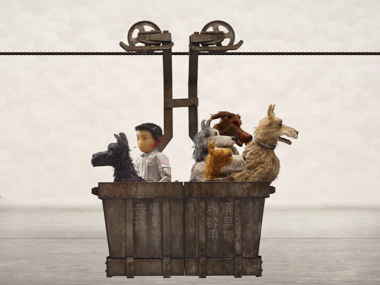Wes Anderson’s films are wondrously created universes, peopled with eccentric characters and dense with exquisite, artistic detail. His Isle of Dogs , which opened the Berlin Film Festival on 15 February, is absolutely brilliant. What’s more, it is a stop-motion animation feature.
His last feature, The Grand Budapest Hotel, that had also opened the Berlinale in 2014, was also marvelous. But Isle of Dogs surpasses it, quite a feat. Anderson is an American auteur and genius from Texas, whose films often have a confectionery bonhomie that conceals sly or sometimes sharp socio-political comment. His films include the stop motion animation feature Fantastic Mr Fox, a Roald Dahl adaptation. He seems to nourish a keen appetite for foreign cultures: The Grand Budapest Hotel was a period film set in central Europe; his delightful film The Darjeeling Limited, set in India, was about three firangi brothers who travel across the country by train in an attempt to bond as a family; his Isle of Dogs is set in Japan.
In fact_, Isle of Dogs_ is set in a dystopian, futuristic Japan 20 years hence. It is about the odyssey of a boy, Atari, 12, who lives in the fictional Megasaki City and goes to Trash Island in search of his beloved dog Spots. Orphaned when young, he has been adopted by his uncle, the corrupt Mayor Kobayashi. Claiming that their Uni Prefecture is in danger of dog flu spreading to humans, he decrees that all dogs be deported to Trash Island far away, starting with his own dog Spots who had been assigned to guard Atari. The mayor has brainwashed the public that their lives are in danger and he alone is their saviour.
Since nobody questions the mayor — except a few scientists whom everybody ignores — Atari daringly flies alone to the island in a sputtering plane to look for Spots. Trash Island is a toxic, industrial wasteland in which the dogs have grown savage or diseased. Initially suspicious of Atari, a group of five dogs, led by Rex and Chief, realise that he is the only human master who has come to the island in search of his pet, while they have all been abandoned. As they all gang up to help him look for Spots, we meet a number of interesting canine characters who reminisce about their former lives as a show dog, a baseball mascot and a star of Doggy Chop pet food commercials.
Meanwhile, as Atari goes missing, Tracy Walker, a spunky pre-teen American exchange student in a Japanese school, raises the alarm in a school newspaper. She publicly questions the murky goings-on. It turns out that a greedy pharmaceutical giant has invented the dog flu scare, wholly aided by Kobayashi, and that the latter has even poisoned his political rival, Prof Watanabe of the Scientist Party, who had found a cure for dog flu. The mayor now sends an army of robotic dogs and drones to capture Atari, in order to suppress the truth.
The film takes a resolute stand against political leaders who manipulate the truth to spread paranoia and persecute minorities and scientific, rational voices that question the status quo. Who would imagine that Anderson’s doggie fable, set in futuristic Japan, could comment so stingily about events in contemporary India, where anti-superstition rationalists Narendra Dabholkar, Govind Pansare and MM Kalburgi were murdered for similar reasons? But that is what makes Anderson’s art so great and relevant.
The film raises basic questions: Who are we? And what do we want to be? Anderson takes off from a traditional Japanese fairy tale about a boy Samurai, and underlines how the innocence and courage of children enable them to ask tough questions that adults are too corrupt or cowardly to address. Emotionally too, he draws parallel stories of how an abandoned boy connects with abandoned dogs. The screenplay is written by Anderson, from a story he developed with Roman Coppola, Kunichi Nomura and Jason Schwartzman.
Anderson’s artistry draws from a rich array of Japanese artistic and pop references. These range from Akira Kurosawa (Anderson has acknowledged the influence of Kurosawa’s early urban crime thrillers and there’s a Toshiro Mifune-like figure), Katsushika Hokusai’s famous painting The Great Wave off Kanagawa, to volcanoes spitting purple fire, samurai traditions, Kabuki theatre and manga comics in the way Atari is styled.
The animation of the dogs is astonishingly life-like in its detail, and Andersons’ imagination soars as he creates scenes in which a dog in a cage is carried ceremonially in a procession, palanquin-like, and a cavern made of colourful discarded sake bottles. The characterisation is distinctive. You are drawn to Atari not only for his unswerving courage and loyalty but also because he refuses to be cute — he often wears a scowl and a black eye.
Likewise, for the dogs, and indeed Anderson himself stoutly refuses to be cute — admittedly a major Japanese weakness. There are a lot of sly visual digs — the mesmerising preparation of a delicious bento box turns out to be poison warfare. As always in an Anderson film, there is a wealth of detail in every frame and repeat viewings are bound to yield more treasures. The cinematography is by Tristan Oliver.
The human and doggie protagonists are voiced by Bryan Cranston, Koyu Rankin and Kunichi Nomura — and include top stars and Anderson’s regulars, Bill Murray, Tilda Swinton, Scarlett Johansson and Edward Norton. There are linguistic delights — Atari speaks only Japanese which is not translated but whose meaning you can guess while the titles include a disarming note, “All barks have been rendered into English.” The linguistic gags include a dog who can “understand TV.”
The music, composed by Alexandre Desplat, has hypnotic rhythms, mainly percussion — and whistling — and includes wonderful Japanese taiko drumming. It throbs in your heart — which is by now quite full — long after you have left the theatre. The film is produced by Indian Paintbrush and American Empirical Pictures, and distributed by Fox Searchlight. Let us hope the film comes to India soon!


)




)
)
)
)
)
)
)
)